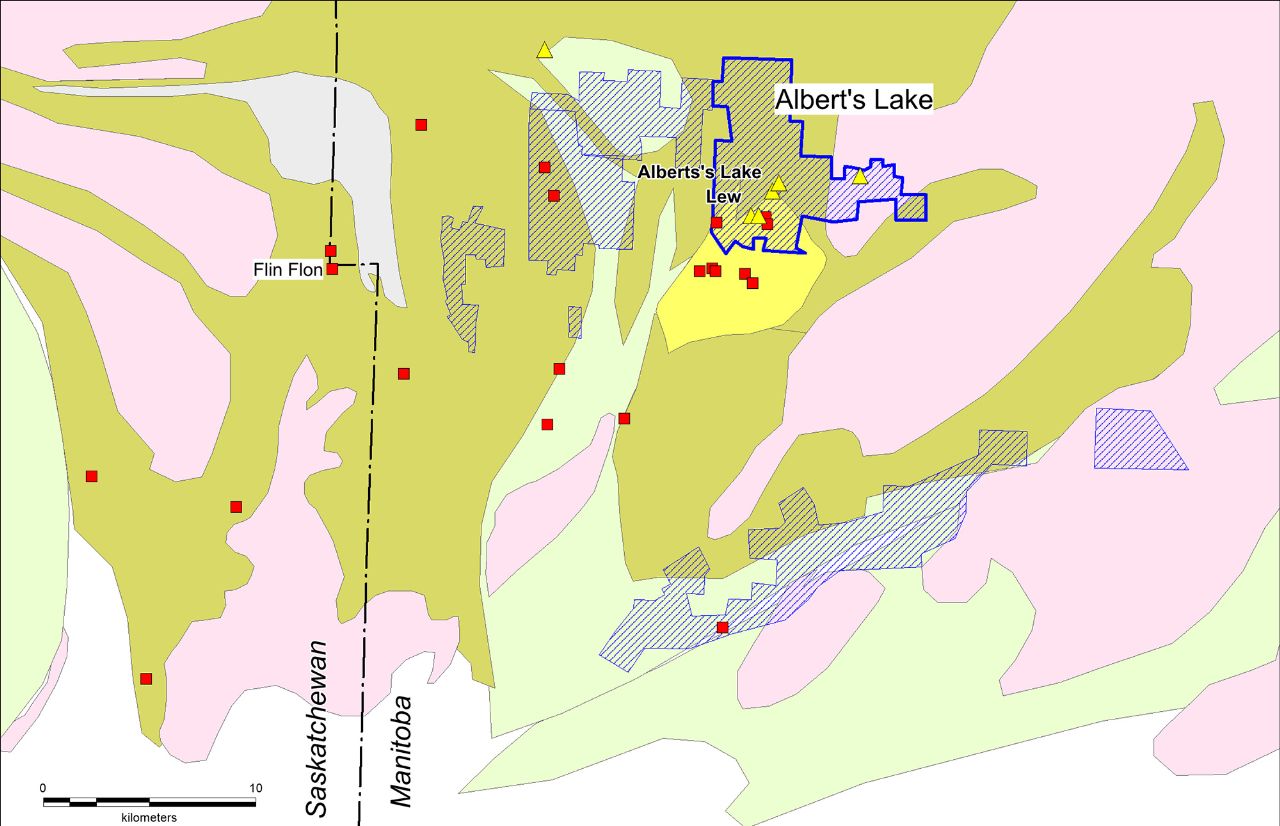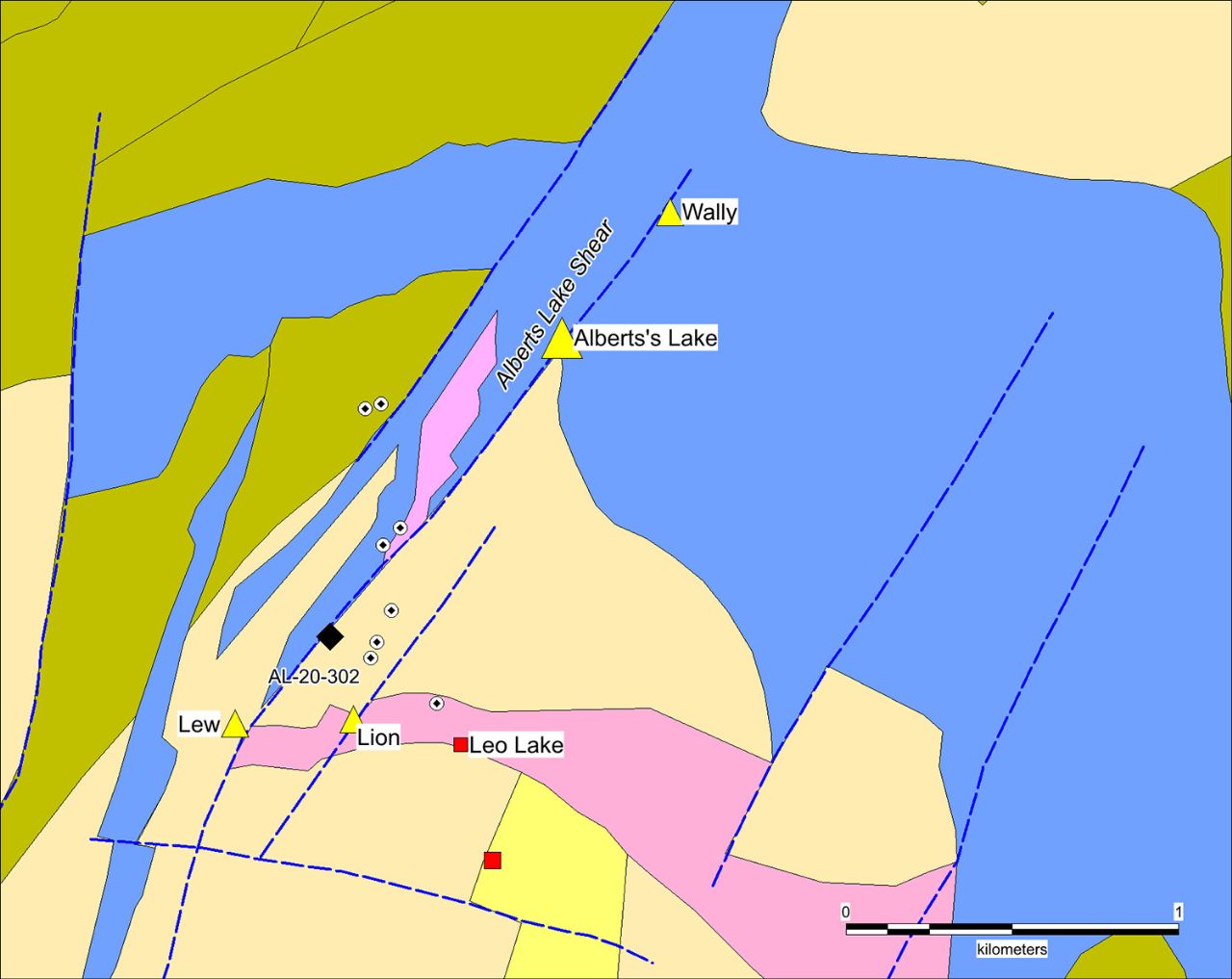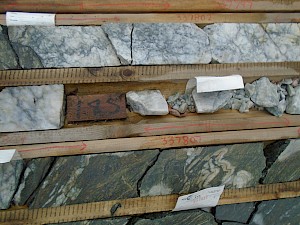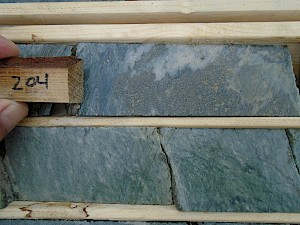Projects
The Albert’s Lake Properties are extensive in size and contains several prospects hosting both Cu-Zn-Au mineralization as well vein-hosted Au-Ag. Most recently, vein-hosted Au has been targeted for exploration near the Albert’s Lake Gold Prospect and along the strike extent of the structure, the Albert’s Lake Shear, hosting mineralization that has been traced at surface and by drilling for over 2km of strike extent.
Current Work
The Albert’s Lake Gold Prospect is the largest of the Au prospects along the structure, where mineralization has been drilled over a 500-metre strike extent to below 300 metres vertical depth. Voyageur drilling confirmed continuity and grades of Au-Ag mineralization across the strike-length of this zone. Results within the zone of mineralization are:
- 3.46 g/t Au over 27.9m; includes 12.19 g/t Au and 33.5 g/t Ag over 4.5m (AL-11-57TW)
- 1.02 g/t Au over 51.5m; includes 6.82 g/t Au and 14.0 g/t Ag over 2.85m (AL-11-61BTW)
- 1.39 g/t Au over 30.9m; includes 5.83 g/t Au and 10.5 g/t Ag over 2.2m (AL-11-40TW)
- 1.14 g/t Au over 26.4m; includes 4.55 g/t Au and 7.1 g/t Ag over 1.85m (AL-11-72TW)
Manitoba Department of Mines Assessment report (Voyageur, 2011)
In February 2020, five holes were drilled for a total of 1,658 metres over 1km south of the Albert’s Lake Gold Prospect targeting the main structure as well as geophysical anomalies in favourable geological settings nearby.
Four Drill Holes were drilled on base metal targets with two holes intersecting copper stringer mineralization in strongly altered felsic volcanic rocks shouldering an IP chargeability anomaly. The Copper stringer zone appears to be extended over 100 metre in strike length.
- DDH AL-20-302 intersected an exhalite horizon of barren sulphides 50 metres south of and apparently stratigraphically on strike with the copper stringer zone intersected in DD-AL-20-204. High grade gold was intersected in AL-20-302 in a quartz vein within the Alberts Lake Shear Zone from 188.24 to 189.00 metres (0.76m) which assayed 29.27g/t Au and 91.6g/t Ag where the hole targeting base metals also crossed the Alberts Lake Deformation zone.
- DDH AL-20-303 assayed 1.37% Cu over 0.24 metres in semi massive sulphides from 261.63 to 261.85 metres and 1.55% Cu over 0.30 metres in a chalcopyrite stringer from 445.18 to 445.48 metres.
- DDH AL-20-304 which assayed 3.08% Cu over 1.35 m.
One hole (AIM-20-01) was drilled in the Aimee Lake property with no significant assays being returned.
Geological Setting and Prospectivity
The Albert’s Lake Shear Zone is a well-defined structure that transects the Baker Patton Complex and offsets mafic intrusive rocks mapped throughout the area (Figure 1). The Baker Patton Complex is a large felsic volcanic and intrusive centre that has been previously explored for VMS-type Cu-Zn-Au-Ag mineralization. In addition, Au mineralization is exposed at surface along the shear zone. Au-Ag mineralization has been found along a 2km portion of the strike extent of the structure at the Lew, Albert’s Lake, and Wally Prospects as well as the new area drilled by Voyageur in 2020.
Figure 1. Bedrock geology of the Albert’s Lake area (after Gale and Dudek, 2002). The black diamond identifies the location of the intersection of the Albert’s Lake Shear Zone by the 2020 drilling.
The Lew Prospect occurs over 2km south of the Albert’s Lake Gold Prospect along the same structure. Grab samples from the Lew Prospect at surface have returned values of up to 26.1 g/t Au. Previous drilling at the Lew Prospect intersected Au mineralization in several holes with some of the best results reported as:
- 8.37 g/t Au over 1.0 m and 17.35 g/t Au over 1.0 m.
Manitoba Department of Mines Assessment Report (Aur Resources Inc., 1999)
At the Lew Prospect, most historic holes are shallow; drilled to a depth between 100 and 200 metres, and mineralization remains open down plunge within the Albert’s Lake Shear Zone.
The Wally Prospect is north of the Albert’s Lake Gold Prospect and hosted within mafic intrusive rocks. Previous drilling has intersected Au-Ag mineralization up to 3.59 g/t Au and 13.1 g/t Ag over 1.45 metres at shallow depths of less than 50 metres (Manitoba Department of Mines Assessment Report, Voyageur 2011). Mineralization at the Wally Prospect is narrow but does demonstrate the widespread presence of Au-Ag along the strike length of this structure.
The Lion Prospect is interpreted to occur along a separate, parallel structure to the Albert’s Lake Shear Zone. Gold mineralization has been intersected by drilling with the highest value returning 38.48 g/t Au and 49.84 g/t Ag over 3 metres (Manitoba Department of Mines Assessment Report Aur Resources Inc., 1999). Mineralization has been traced to over 100 metres at depth and most drill holes do not extend beyond 200 metres depth.
The style of mineralization is similar at all of the prospects along the Albert’s Lake Shear Zone; consisting of Au and Ag within quartz-carbonate veins that are folded and deformed (see drill core photos). Intense carbonate and sericite alteration of both the host felsic intrusive and extrusive rocks as well as the mafic intrusive rocks is well developed. Pyrite is widespread; associated with Au and Ag mineralization within the veins as well as discrete bands throughout the wallrock and may reflect a broad mineralization system developed before and during deformational events related to emplacement of the Au-Ag bearing veins.
Core photos from Voyageur drilling. Left: Gold-silver mineralization Albert’s Lake Gold Prospect. Folded quartz-carbonate veins within sheared and altered wallrock near the contact between felsic rock and mafic intrusion. Right: 2020 drilling intersection (AL-20-302) of Au-Ag in quartz-carbonate veins and pyrite within sericitized felsic porphyry.
Previous work at the Lew and Lion Prospects has found the felsic rocks within the Baker Patton Complex can be sub-divided using trace element geochemistry and that structures associated with gold-bearing quartz-carbonate veins are best developed along lithological contacts.
At the Albert’s Lake Prospect, shearing and deformation is best developed along the contact between felsic rocks of the Baker Patton Complex and mafic intrusive rocks. The mafic intrusions are well identified regionally in magnetic survey data (Figure 2). In addition to faulting and shearing, folding of the large mafic intrusion is also reflected by the magnetic data, that may correspond to the folding event in the quartz-carbonate veins hosting Au-Ag mineralization. The magnetic data also shows that several other northeast trending structures parallel to the Albert’s Lake Shear may be present. East-west trending structures are also discernable in the magnetic data parallel to those mapped from bedrock exposures. The east-west structures are offset and in places terminated by the northeast trending structures illustrating a complex structural history that has not been extensively explored beyond the obvious surface exposures of mineralization.
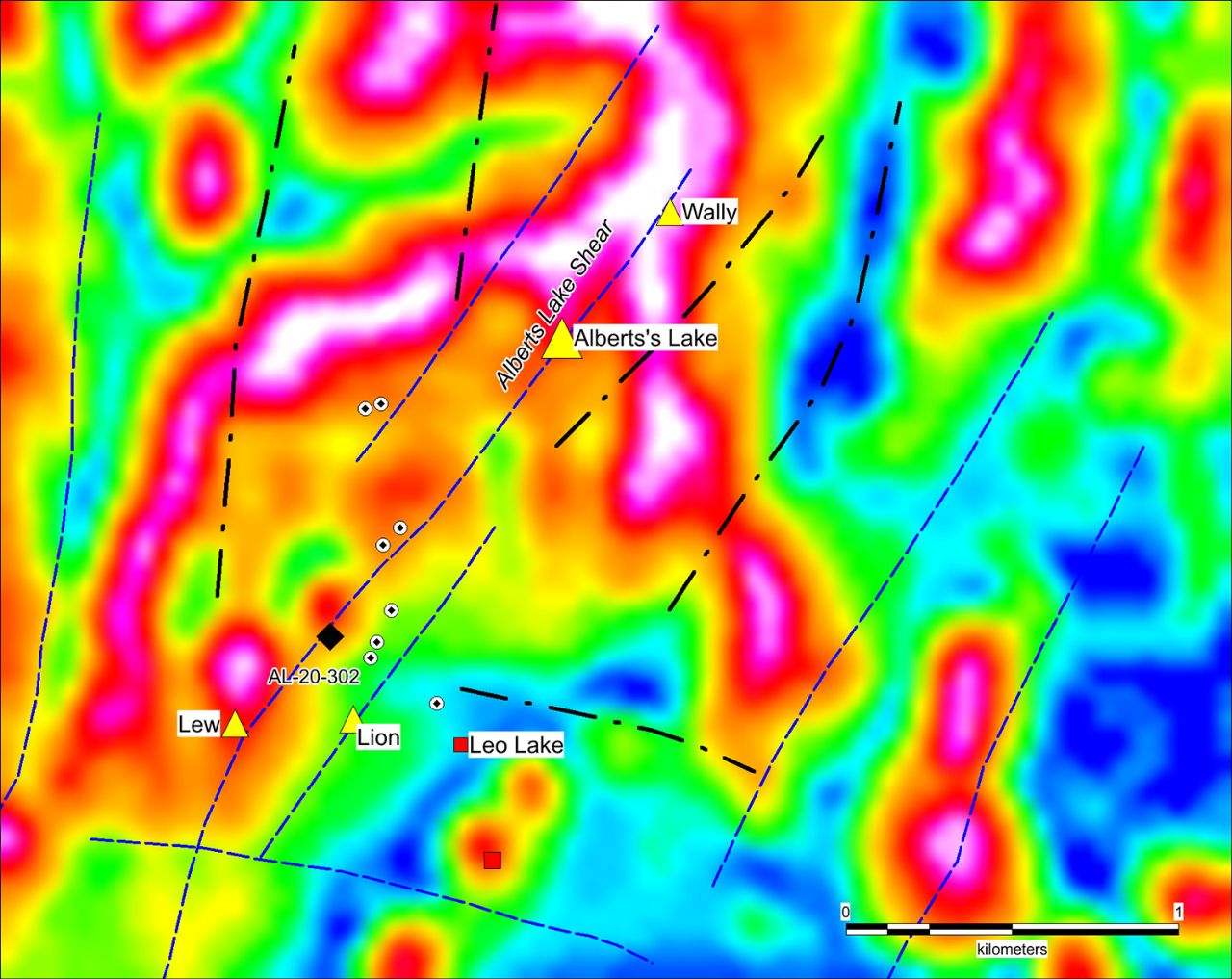
Figure 2. Magnetic data map of the Albert’s Lake area (Voyageur 2010 airborne survey; 200 m line spacing). Structures interpreted from the magnetic data shown by black-dash-dot lines.


